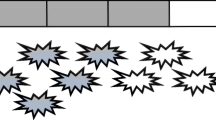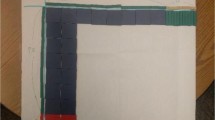Abstract
The part-whole multiplicative relationship, as a topic that gives rise to the concept of fraction, is fundamental in education at the primary school level, and must therefore be included in training courses for prospective primary school teachers (PSTs). In this paper, we introduce a first study of a larger project, which aims to understand the usefulness of a semantic triangle in studying prospective teachers’ knowledge of various mathematical topics. In particular, we present the results of a study focused in the starting level of the fraction concept, based on the multiplicative part-whole relationship. We carried out this study with PSTs by means of a questionnaire. We analyzed the collected responses using a framework of three components that form a semantic triangle, in terms of their conceptual structure, system of representations, and contexts and modes of use of the part-whole relationship. The results show different typologies of meaning expressed by the participants in terms of the semantic triangle. Each typology emphasizes some aspects of the meaning of the part-whole relationship such as the equality of parts, the model of area as representation and the context of division.


Similar content being viewed by others
References
Ball, D. (1990). Preservice elementary and secondary teachers’ understanding of division. Journal for Research in Mathematics Education, 21(2), 132–144.
Behr, M., Khoury, H., Harel, G., Post, T., & Lesh, R. (1997). Conceptual units analysis of preservice elementary school teachers’ strategies on a rational number as operator task. Journal for Research in Mathematics Education, 28(1), 48–69.
Behr, M. J., Lesh, R., Post, T. R., & Silver, E. A. (1983). Rational number concept. In R. Lesh & M. Landau (Eds.), Acquisitions of mathematics concepts and processes (pp. 91–126). New York: Academy Press.
Carpenter, T. P., Fennema, E., & Romberg, T. A. (1993). Rational numbers: An integration of research. Hillsdale: LEA.
Castro-Rodríguez, E., Rico, L., & Gómez, P. (2013, July). Meanings of fractions as demonstrated by future primary teachers in the initial phase of teacher education. Paper presented at the 12th ICME, Seoul, Korea.
Charalambous, C. Y., & Pitta-Pantazi, D. (2007). Drawing on theoretical model to study students’ understanding of fractions. Educational Studies in Mathematics, 64(3), 293–316.
Cluff, J. J. (2005). Fraction multiplication and division image change in pre-service elementary teachers (Unpublished doctoral dissertation). Brigham Young University, USA.
Cramer, K., & Lesh, R. (1988). Rational number knowledge of preservice elementary education teachers. In M. Behr (Ed.), Proceedings of the 10th annual meeting of the North American chapter of the international group for psychology of mathematics education (pp. 425–431). DeKalb: PME.
Domoney, B. (2001). Student teachers’ understanding of rational numbers. In J. Winter (Ed.), Proceedings of the British society for research into learning mathematics (Vol. 21, pp. 13–18). Southampton: BSRLM.
Figueras, O. (1988). Dificultades de aprendizaje en dos modelos de enseñanza de los racionales (Unpublished doctoral dissertation). Cinvestav, Mexico.
Freudenthal, H. (1983). Didactical phenomenology of mathematical structures. Dordrecht: Reidel.
Hiebert, J., & Carpenter, T. P. (1992). Learning and teaching with understanding. In D. Grouws (Ed.), Handbook of research on mathematics learning and teaching (pp. 65–97). New York: Macmillan Publishing Company.
Hill, H. C., Ball, D. L., & Schilling, S. G. (2008). Unpacking pedagogical content knowledge: Conceptualizing and measuring teachers’ topic-specific knowledge of students. Journal for Research in Mathematics Education, 39(4), 372–400.
Kaput, J. (1987). Towards a theory of symbol use in mathematics. In C. Janvier (Ed.), Problems of representation in the teaching and learning of mathematics (pp. 159–195). Hillsdale: LEA.
Kieren, T. E. (1976). On the mathematical, cognitive, and instructional foundations of rational numbers. In R. Lesh (Ed.), Number and measurement (pp. 101–144). Columbus: ERIC-SMEAC.
Kieren, T. E. (1993). The learning of fractions: maturing in a fraction. Paper presented at the conference fraction learning and instruction, GA, Athens.
Kurt, G., & Cakiroglu, E. (2009). Middle grade students’ performances in translating among representations of fractions: A Turkish perspective. Learning and Individual Differences, 19, 404–410.
Lo, J., & Grant, T. (2012). Preservice elementary teachers’ conceptions of fractional units. In T. Y. Tso (Ed.), Proceedings of the 36th PME (Vol. 3, pp. 169–176). Taipei: PME.
McMillan, J. H., & Schumacher, S. (2006). Research in education. New York: Longman.
Morgan, C., & Kynigos, C. (2014). Digital artefacts as representations: Forging connections between a constructionist and a social semiotic perspective. Educational Studies in Mathematics, 85(3), 357–379.
Newton, K. J. (2008). An extensive analysis of preservice elementary teachers’ knowledge of fractions. American Educational Research Journal, 45(4), 1080–1110.
Park, J., Güçler, B., & McCrory, R. (2012). Teaching preservice teachers about fractions: Historical and pedagogical perspectives. Educational Studies in Mathematics, 82(3), 455–479.
Philippou, G., & Christou, C. (1994). Preservice elementary teachers’ conceptual and procedural knowledge of fractions. In J. P. Ponte & J. F. Matos (Eds.), Proceedings of the 18 th conference of the international group for the psychology of mathematics education (Vol. 4, pp. 33–40). Lisbon: PME.
Piaget, J., Inhelder, B., & Szeminska, A. (1960). The Child’s conception of geometry. New York, NY: Basic Books.
Pinto, M., & Tall, D. (1996). Student teachers’ conceptions of the rational number. In L. Puig & A. Gutierrez (Eds.), Proceedings of the 20th conference of the international group for the psychology of mathematics education (Vol. 4, pp. 139–146). Valencia: PME.
Pitkethly, A., & Hunting, R. (1996). A review of recent research in the area of initial fraction concepts. Educational Studies in Mathematics, 30(1), 5–38.
Ponte, J. P., & Chapman, O. (2008). Preservice mathematics teachers’ knowledge and development. In L. D. English (Ed.), Handbook of international research in mathematics education (pp. 223–261). New York: Routledge.
Post, T., Harel, G., Behr, M., & Lesh, R. (1988). Intermediate teachers knowledge of rational number concepts. In E. Fennema, T. P. Carpenter, & S. J. Lamon (Eds.), Papers from first Wisconsin symposium for research on teaching and learning mathematics (pp. 194–219). Madison: WCER.
Radford, L. (2003). Gestures, speech, and the sprouting of signs: A semiotic-cultural approach to learners’ types of generalization. Mathematical Thinking and Learning, 5(1), 37–70.
Rico, L. (2009). Sobre las nociones de representación y comprensión en la investigación en educación matemática. PNA, 4(1), 1–14.
Sáenz-Ludlow, A. (2006). Learning mathematics: Increasing the value of initial mathematical wealth. Revista Latinoamericana de Investigación en Matemática Educativa [Special issue], 225–245.
Steffe, L. P., & Olive, J. (1990). Constructing fractions in computer microworlds. In G. Booker, P. Cobb, & T. N. de Mendicuti (Eds.), Proceedings of the 14th conference of the international group for the psychology of mathematics education (Vol. 3, pp. 59–66). Mexico: CONACYT.
Steffe, L. P., & Olive, J. (1993). Children’s construction of the rational numbers of arithmetic. Paper presented at the international study group on the rational numbers of arithmetic, GA, Athens.
Steinbring, H. (1989). Routine and meaning in the mathematics classroom. For the Learning of Mathematics, 9(1), 24–33.
Steinbring, H. (2006). What makes a sign a mathematical sign? An epistemological perspective on mathematical interaction. Educational Studies in Mathematics, 61, 133–162.
Streefland, L. (1991). Fractions in realistic mathematics education: a paradigm of developmental research. Dordrecht: Kluwer Academic Publishers.
Tatto, M. T., Schwille, J., Senk, S. L., Bankov, K., Rodriguez, M., Reckase, M., . . . Peck, R. (2012). The Teacher Education Study in Mathematics (TEDS-M): Policy, practice, and readiness to teach primary and secondary mathematics. Findings from the IEA Study of the mathematics preparation of future teachers. Amsterdam, the Netherlands: IEA.
Tichá, M., & Hŏspesová, A. (2013). Developing teachers’ subject didactic competence through problem posing. Educational Studies in Mathematics, 83(1), 133–143.
Toluk-Uçar, Z. (2009). Developing pre-service teachers’ understanding of fractions through problem posing. Teaching and Teacher Education, 25(1), 166–175.
Van den Heuvel-Panhuizen, M. (2014). Didactical phenomenology (Freudenthal). In S. Lerman (Ed.), Encyclopedia of mathematics education (pp. 174–176). Heidelberg: Springer.
Wright, K. B. (2008). Assessing ec-4 preservice teachers’ mathematics knowledge for teaching fractions concepts. Unpublished dissertation, University of Texas, USA.
Acknowledgment
This study was supported from project “Procesos de aprendizaje del profesor de matemáticas en formación” EDU2012-33030 (MICINN) and by the Group FQM-193 of the 3rd Andalusian Research Plan (PAIDI).
Author information
Authors and Affiliations
Corresponding author
Rights and permissions
About this article
Cite this article
Castro-Rodríguez, E., Pitta-Pantazi, D., Rico, L. et al. Prospective teachers’ understanding of the multiplicative part-whole relationship of fraction. Educ Stud Math 92, 129–146 (2016). https://doi.org/10.1007/s10649-015-9673-4
Published:
Issue Date:
DOI: https://doi.org/10.1007/s10649-015-9673-4




